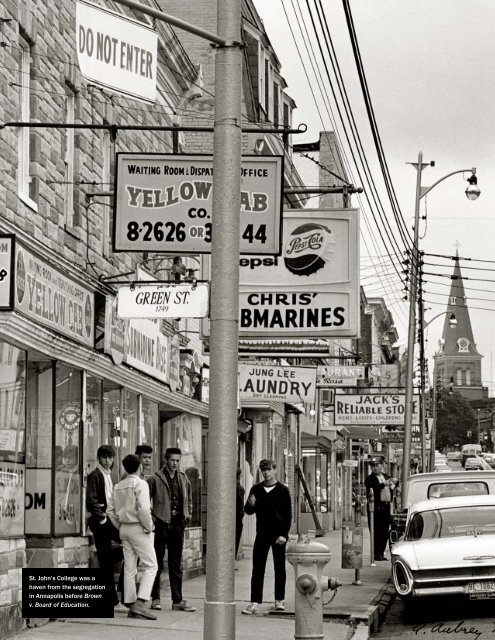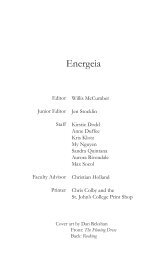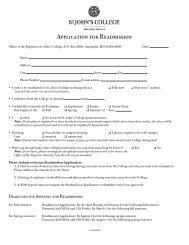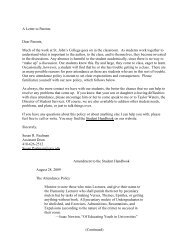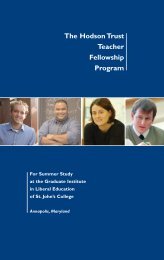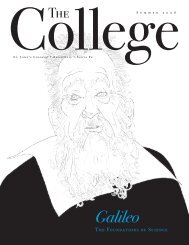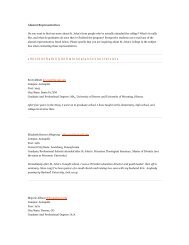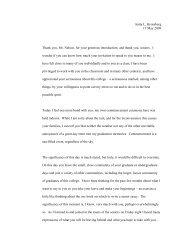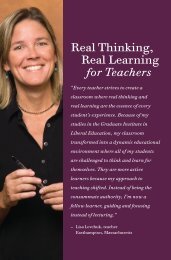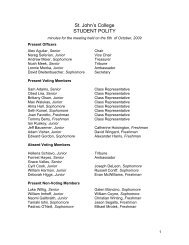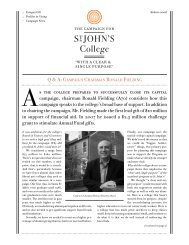Rule of Reason - St. John's College
Rule of Reason - St. John's College
Rule of Reason - St. John's College
You also want an ePaper? Increase the reach of your titles
YUMPU automatically turns print PDFs into web optimized ePapers that Google loves.
<strong>St</strong>. John’s <strong>College</strong> was a<br />
haven from the segregation<br />
in Annapolis before Brown<br />
v. Board <strong>of</strong> Education.<br />
34 | The <strong>College</strong> | st. john’s college | summer 2012
<strong>Rule</strong> <strong>of</strong><br />
<strong>Reason</strong><br />
In a Small <strong>College</strong> Seeking<br />
Enlightenment<br />
by Susan Borden (A87)<br />
SIGNS, WIRES AND CONCRETE. PHOTOGRAPH BY A. AUBREY BODINE, COPYRIGHT © JENNIFER B. BODINE, COURTESY WWW.AAUBREYBODINE.COM<br />
Remembering<br />
Martin A. Dyer<br />
(193o–2011)<br />
Martin Appell Dyer (Class <strong>of</strong> 1952), was<br />
a dignified, thoughtful, and gracious<br />
pioneer, the first African American<br />
student to attend <strong>St</strong>. John’s <strong>College</strong>. He<br />
was admitted in 1948 after the college<br />
community challenged the legitimacy <strong>of</strong><br />
segregated education. Throughout his<br />
distinguished career as an attorney in<br />
public and community service, Mr. Dyer<br />
remained devoted to <strong>St</strong>. John’s.<br />
He recalled how he “was welcomed on<br />
campus, a bastion, and that welcome<br />
made all the difference in the world...<br />
<strong>St</strong>. John’s was just a beacon <strong>of</strong> freedom<br />
compared to anything in Annapolis.”<br />
It was to <strong>St</strong>. John’s that Mr. Dyer attributed<br />
his “lifelong love <strong>of</strong> books and<br />
language” and his “passion for music.”<br />
During his time at <strong>St</strong>. John’s, Mr. Dyer<br />
arranged for W.E.B. Du Bois to give a<br />
lecture—he brought to campus the only<br />
author read in the <strong>St</strong>. John’s Program to<br />
also visit and speak at the college.<br />
Mr. Dyer was born and raised in East<br />
Baltimore, the son <strong>of</strong> Martin A. Dyer, a<br />
steelworker, and Margaret Louise Dyer, a<br />
secretary to Lillie Mae Jackson, president<br />
<strong>of</strong> the Baltimore chapter <strong>of</strong> the NAACP.<br />
What can the voices <strong>of</strong> <strong>St</strong>. John’s<br />
veterans returning after World War II<br />
tell us about freedom, injustice, and<br />
segregation in a small college town?<br />
In the crowded Conversation Room at the 2011 Annapolis<br />
Homecoming, more than 60 alumni, tutors, and other<br />
members <strong>of</strong> the college community gathered for a first<br />
reading <strong>of</strong> “So <strong>Reason</strong> Can <strong>Rule</strong>: The Necessity <strong>of</strong> Racial<br />
Integration at <strong>St</strong>. John’s <strong>College</strong>.” The script, drawn from<br />
numerous oral histories and written by Charlotta Beavers<br />
(AGI11), tells the story <strong>of</strong> the conditions, circumstances,<br />
and people that led to the enrollment <strong>of</strong> Martin Dyer<br />
Martin Dyer (Class <strong>of</strong> 1952) (Class <strong>of</strong> 1952), the first African<br />
American student to attend <strong>St</strong>. John’s<br />
<strong>College</strong>. Dyer enrolled in the fall<br />
<strong>of</strong> 1948, six years before Brown v.<br />
Board <strong>of</strong> Education established the<br />
unconstitutionality <strong>of</strong> separate public<br />
schools for black and white students.<br />
The <strong>College</strong> | st. john’s college | summer 2012 | 35
Remembering<br />
Martin A. Dyer<br />
(continued)<br />
He graduated at the top <strong>of</strong> his<br />
class in 1948 at Paul Laurence<br />
Dunbar High School but family<br />
circumstances were such that<br />
he expected to attend a state<br />
teachers college. At that time,<br />
students and faculty from<br />
<strong>St</strong>. John’s actively sought<br />
African Americans to attend<br />
the college and Mr. Dyer was<br />
the first to enroll. Inspired by<br />
the college’s activist stance,<br />
he attended the college after<br />
“a core <strong>of</strong> students actively<br />
scouted Baltimore’s two black<br />
high schools to recruit students<br />
for a college virtually unknown<br />
in the black community. . . . To<br />
accept [blacks] is one thing,”<br />
he told a reporter from the Baltimore<br />
Sun, “but to deliberately<br />
and consciously seek someone<br />
is another.”<br />
Graduating from <strong>St</strong>. John’s in<br />
1952, he enlisted in the Army<br />
and served in Europe until<br />
1954. Mr. Dyer earned his law<br />
degree from the University<br />
<strong>of</strong> Maryland School <strong>of</strong> Law in<br />
1959. In 1962, Mr. Dyer married<br />
the former Jane Weeden<br />
and began his family.<br />
In the 1960s, Mr. Dyer worked<br />
as a congressional intern on<br />
Capitol Hill and principal legislative<br />
aide and speechwriter for<br />
Alaska Sen. Edward L. “Bob”<br />
Bartlett, architect <strong>of</strong> Alaskan<br />
statehood. Mr. Dyer then<br />
worked in public service in the<br />
Health Care Finance Administration<br />
until retiring in 1990. A<br />
champion for fair housing, after<br />
retiring from federal service he<br />
served as associate director <strong>of</strong><br />
Baltimore Neighborhoods, Inc.<br />
In 1997 he was honored at<br />
Homecoming with the Alumni<br />
Association Award <strong>of</strong> Merit. He<br />
gave a moving talk to those<br />
“ I learned about discrimination and segregation<br />
when I was sent to Fort Bragg. It had an impact for<br />
everybody. Whether you were a southerner or urban<br />
or rural—just being in the military and<br />
wondering why [the soldiers] were<br />
separated . . . made you think.”<br />
—Jules Pagano (Class <strong>of</strong> 1948)<br />
When Beavers started working on “So <strong>Reason</strong><br />
Can <strong>Rule</strong>,” its working title was “The Magnificent<br />
Seven,” a name affectionately bestowed on<br />
the first seven African American students to<br />
enroll at <strong>St</strong>. John’s by Everett Wilson (Class <strong>of</strong><br />
1956), the second African American student.<br />
Beavers came to see that her project was about<br />
far more than these seven alumni. It was about<br />
a world seeking enlightenment after the darkness<br />
<strong>of</strong> World War II. It was also about deeply<br />
entrenched prejudice in a small southern city,<br />
and the necessity <strong>of</strong> racial justice in an institution<br />
centered on liberty, open-mindedness, and<br />
the rule <strong>of</strong> reason.<br />
“So <strong>Reason</strong> Can <strong>Rule</strong>” originated as an oral<br />
history project; Beavers conducted 13 oral histories<br />
as a collective memory <strong>of</strong> a pivotal time at the<br />
college. As Beavers reviewed the recordings and<br />
transcripts <strong>of</strong> these oral histories, she noticed a<br />
theme that seemed essential to the college’s integration:<br />
the significant role played by veterans<br />
returning to the college from World War II.<br />
In his essay, “Race, Language, and War in Two<br />
Cultures: World War II in Asia,” author John<br />
W. Dower describes the U.S. soldiers’ need to<br />
remain blind to the “hypocrisy <strong>of</strong> fighting with<br />
a segregated army and navy under the banner<br />
<strong>of</strong> freedom, democracy, and justice.” To their<br />
credit, Beavers says, many <strong>St</strong>. John’s students returned<br />
from World War II with their eyes opened.<br />
“I learned about discrimination and segregation<br />
when I was sent to Fort Bragg,” says Jules<br />
Pagano (Class <strong>of</strong> 1948). “It had an impact for<br />
everybody. Whether you were a southerner or<br />
urban or rural—just being in the military and<br />
wondering why [the soldiers] were separated . . .<br />
made you think.”<br />
George Van Sant (Class <strong>of</strong> 1948), another<br />
veteran, returned to the college in 1947 as a junior,<br />
joining a student body <strong>of</strong> mostly veterans,<br />
including the dean, who had been “commander<br />
<strong>of</strong> a company <strong>of</strong> all black soldiers that had fought<br />
in Germany with distinction,” Van Sant recalls.<br />
“By the junior year, you begin to read some <strong>of</strong><br />
the 18th-century political stuff. Most Johnnies<br />
develop, I hope, a very enlightened view <strong>of</strong> our<br />
Founding Fathers and their Constitution and<br />
what it all means.”<br />
Van Sant says that his senior year saw a lot <strong>of</strong><br />
ferment and turmoil. “The race issue just came<br />
to a head and there was an open discussion <strong>of</strong><br />
it and open encouragement for [integration on<br />
the campus].” A voluntary meeting in the Great<br />
Hall about the issue during the ’47 to ’48 academic<br />
year was well attended, he says, by a lot <strong>of</strong><br />
students and veterans.<br />
Pagano recalls the sense <strong>of</strong> political possibility<br />
that informed the meeting: “Just the fact that<br />
we were reading the Great Books made us very<br />
concerned with the movements that were taking<br />
place: Will there be something like the Roman<br />
peace? Will there be an American peace? Will<br />
we run the world? Will we be the new empire?<br />
What will the United Nations be and how will<br />
it affect us? Will it change America and will we<br />
have a voice in the world?”<br />
Charged with the possibility <strong>of</strong> change and the<br />
hope for a better world, the undergraduate students<br />
gathered on March 16, 1948, to vote on a<br />
resolution: “The <strong>St</strong>udent Polity hereby resolves<br />
that it would welcome the admission <strong>of</strong> students<br />
<strong>of</strong> any race or color to <strong>St</strong>. John’s <strong>College</strong>,” it read.<br />
“This resolution is not intended as a petition to<br />
or demand on the administration, but rather is<br />
the result <strong>of</strong> a student discussion and deliberation<br />
about whether an admissions policy which<br />
would enter Negro students would be acceptable<br />
to the student body.”<br />
Gene Thornton (Class <strong>of</strong> 1945), who served in<br />
the Navy with African American men, reflected<br />
on freedom and segregation: “You get to thinking<br />
about things, and you realize you want to do<br />
something about them.” He drew up the petition<br />
that circulated among the students before<br />
36 | The <strong>College</strong> | st. john’s college | summer 2012
“ The race issue just came to a head and there was<br />
an open discussion <strong>of</strong> it and open encouragement<br />
for [integration on the campus]. A voluntary<br />
meeting in the Great Hall about the<br />
issue was ‘well attended.’”<br />
—George Van Sant (Class <strong>of</strong> 1948)<br />
Remembering<br />
Martin A. Dyer<br />
(continued)<br />
the meeting, which asked what students thought<br />
<strong>of</strong> <strong>St</strong>. John’s enrolling “colored” or “Negro”<br />
students.<br />
Robert Davis (Class <strong>of</strong> 1945) was the meeting’s<br />
moderator. He argued against the idea that<br />
the high tuition ($1,100 in 1948) and the study <strong>of</strong><br />
the Classics were deterrents for African American<br />
students. Unlike others, who thought that<br />
African Americans would forego <strong>St</strong>. John’s for<br />
job preparation training, Davis believed that a<br />
<strong>St</strong>. John’s education was practical and that African<br />
American students would come if they were<br />
welcomed.<br />
Ralph Finkel (now known as Raphael Ben-<br />
Yosef, Class <strong>of</strong> 1948), Michael Keane (Class <strong>of</strong><br />
1945), and Phillip Camponeschi (Class <strong>of</strong> 1946)<br />
assisted in organizing the meeting. Finkel told a<br />
reporter, “You can’t go to a place like <strong>St</strong>. John’s<br />
and learn all about the great ideas <strong>of</strong> the world<br />
without practicing them.” Keane felt strongly<br />
that the challenge to dismantle segregated<br />
education must originate with the students.<br />
Camponeschi, who led seminars on Greek and<br />
Shakespearean tragedies in the African American<br />
communities <strong>of</strong> Annapolis, was recorded as<br />
saying, “Western civilization has lagged intellectually<br />
while developing its material wealth.”<br />
The students concluded that if all men are<br />
free, then a system that denies the right <strong>of</strong> freedom<br />
to certain men is wrong. The resolution<br />
passed by an overwhelming vote: 162 in favor, 33<br />
against, and two indifferent.<br />
Less than a month later, at a faculty meeting<br />
on April 10, a motion was made by tutor Winfree<br />
Smith that “the faculty go on record as favoring<br />
the admission <strong>of</strong> Negro students as a matter <strong>of</strong><br />
college policy.” The motion passed unanimously.<br />
The Board <strong>of</strong> Visitors and Governors met on<br />
April 17. Richard F. Cleveland, the son <strong>of</strong> former<br />
President Grover Cleveland, presided as Chairman.<br />
President John Kieffer told the Board about<br />
the decisions made by the students and faculty.<br />
The Board was facing a number <strong>of</strong> pressures<br />
that seemed to endanger the college’s very<br />
existence, most significantly a recent attempt<br />
by the U.S. Naval Academy to take over the college.<br />
Given the high level <strong>of</strong> segregation in the<br />
city <strong>of</strong> Annapolis, they also feared that publicity<br />
surrounding a new policy <strong>of</strong> integration would<br />
turn the town against <strong>St</strong>. John’s. Following their<br />
discussion, the Board decided unanimously that<br />
no action be taken.<br />
Despite the Board’s reluctance to integrate<br />
the college, the students pressed on. With<br />
the support <strong>of</strong> New Program founder Scott<br />
Buchanan, Dean Harvey Poe, and tutor Winfree<br />
Smith, they visited guidance <strong>of</strong>fices in black<br />
high schools in Baltimore to recruit an African<br />
American male to attend <strong>St</strong>. John’s. In his interview,<br />
Van Sant made it clear that special credit<br />
should be given to Peter Davis (Class <strong>of</strong> 1948),<br />
who spurred this recruitment movement.<br />
“Doctor Weaver founded a Negro<br />
national scholarship fund. . . .<br />
Their one sentence <strong>of</strong> <strong>St</strong>. John’s:<br />
‘<strong>St</strong>. John’s <strong>College</strong> is an island <strong>of</strong><br />
liberality in a sea <strong>of</strong> segregation.’<br />
And the next sentence went on to<br />
explain that fortunately everything<br />
you needed was on campus, so<br />
you did not need to depend on <strong>of</strong>fcampus<br />
for anything else, except<br />
if you went to church, [a dentist, or<br />
for a haircut].”<br />
Jerry Hynson (Class <strong>of</strong> 1959) came<br />
from a segregated community where<br />
his only connections to white people<br />
were as employers. Nevertheless,<br />
he found life at the nearly all-white<br />
<strong>St</strong>. John’s agreeable: “<strong>St</strong>. John’s was<br />
easy socially. . . I liked to talk and<br />
enjoyed the company <strong>of</strong> others.”<br />
assembled. His great care and<br />
concern for each individual<br />
made all who knew him feel<br />
welcome. In his honor <strong>St</strong>.<br />
John’s initiated the Martin<br />
Dyer Book Fund in 1997, which<br />
helps students meet the expenses<br />
<strong>of</strong> Program books.<br />
In 2004, <strong>St</strong>. John’s honored Mr.<br />
Dyer and six other pioneering<br />
African American students<br />
who followed him at <strong>St</strong>. John’s<br />
in the 1950s. He served as<br />
a member <strong>of</strong> the Board <strong>of</strong><br />
Visitors and Governors and<br />
chaired an advisory committee<br />
in Annapolis to recruit, enroll,<br />
and retain students <strong>of</strong> color.<br />
He helped frame the college’s<br />
continuing conversation about<br />
diversity. He drew attention<br />
to the college’s ongoing need<br />
to ensure that its Program is<br />
available to all. He wanted <strong>St</strong>.<br />
John’s to keep the commitment<br />
it had made when he was<br />
recruited and enrolled.<br />
SHERRI HOSFELD JOSEPH<br />
The <strong>College</strong> | st. john’s college | summer 2012 | 37
Remembering<br />
Martin A. Dyer<br />
(continued)<br />
Mr. Dyer included everyone in<br />
the discussion; he could lead a<br />
group around a difficult issue<br />
and never lose sight <strong>of</strong> the<br />
goal. He led with grace and a<br />
finely tuned ability to listen.<br />
“ I had spoken to one or another tutor about my<br />
concern . . . . I was put in touch with somebody<br />
from Baltimore . . . . knowing that there were<br />
the Maryland scholarships that meant someone<br />
recruited in Baltimore could come to<br />
<strong>St</strong>. John’s without having tuition. I<br />
tried to urge that person, whoever they<br />
were, to come to <strong>St</strong>. John’s.”<br />
—Peter Davies (Class <strong>of</strong> 1948)<br />
DAN COOK<br />
A lover <strong>of</strong> art, classical music<br />
and opera and a gourmet chef,<br />
Mr. Dyer was a member <strong>of</strong><br />
the Peabody Choir, a founding<br />
member <strong>of</strong> the board <strong>of</strong> the<br />
James E. Lewis Museum <strong>of</strong> Art<br />
Foundation at Morgan <strong>St</strong>ate<br />
University, and past president<br />
<strong>of</strong> the board <strong>of</strong> Young American<br />
Audiences <strong>of</strong> Maryland.<br />
A tribute by a friend and colleague<br />
might well serve to sum<br />
up his life: “He had no trepidation<br />
about doing what was<br />
right….he made the world not a<br />
little better but a lot better. He<br />
was a perfect gentleman. I have<br />
nothing but fond words and<br />
memories <strong>of</strong> Martin. He was a<br />
beautiful person.”<br />
—Mark Lindley (A67)<br />
The students were put in touch with Martin<br />
Dyer, a senior at Paul Laurence Dunbar High<br />
School in Baltimore, Maryland, and an honors<br />
student with the second-highest grade-point average<br />
in his class.<br />
At the meeting <strong>of</strong> <strong>St</strong>. John’s Board on July 17,<br />
President Kieffer reported that “an application<br />
had been received from Martin Dyer, a Negro,<br />
a graduate <strong>of</strong> Dunbar High School <strong>of</strong> Baltimore<br />
City.” In his opinion, Kieffer said, Martin Dyer’s<br />
application should be accepted if he met all<br />
other qualifications; he should not be rejected<br />
because he was a Negro. Kieffer noted that Johns<br />
Hopkins University admitted Negroes in its<br />
undergraduate department, that the Archbishop<br />
had instructed all Catholic colleges in<br />
Maryland to admit Negroes, and that there was a<br />
Negro at the Naval Academy. To refuse to admit a<br />
Negro to <strong>St</strong>. John’s would be inconsistent with the<br />
“There was so little to do in Annapolis<br />
because <strong>of</strong> the segregation. I certainly<br />
didn’t go socializing <strong>of</strong>f campus<br />
with my classmates unless we<br />
were all going to the Little Campus. I<br />
was Catholic. But I was not welcome<br />
at the Catholic church in Annapolis,<br />
<strong>St</strong>. Mary’s. I certainly didn’t blame it<br />
on <strong>St</strong>. John’s. <strong>St</strong>. John’s opens your<br />
eyes…gives you an opportunity to<br />
think about what is the best way to<br />
respond to this kind <strong>of</strong> travesty.”<br />
Charlotte King (Class <strong>of</strong> 1959) was one<br />
<strong>of</strong> the first African American women<br />
to attend <strong>St</strong>. John’s. She remembers an<br />
admissions <strong>of</strong>ficer showing her and<br />
her family a film <strong>of</strong> the college that<br />
was too good to resist: “I lived in urban<br />
New York and here was this beautiful<br />
movie with beautiful music in the<br />
background, students sitting around at<br />
classes that made it look like a wonderful<br />
way to learn.”<br />
liberal education <strong>of</strong>fered by the college and<br />
would be bad for student and faculty morale.<br />
Yet the Board’s Executive Committee voted<br />
nine to three against admitting Dyer, who was<br />
sent a letter <strong>of</strong> rejection.<br />
What happened next, says Beavers, is unclear.<br />
She speculates that someone on the Board<br />
rallied support for the Executive Committee<br />
<strong>of</strong> the Board to reconsider. A letter dated August<br />
26 shows that the majority <strong>of</strong> the Board<br />
supported such a move. When the Executive<br />
Committee met on September 17, each member<br />
was asked to express his views. Their vote was<br />
six to three—this time in favor <strong>of</strong> admitting Dyer,<br />
who attended his first class at <strong>St</strong>. John’s <strong>College</strong><br />
on September 27, 1948.<br />
The story doesn’t end with Martin Dyer’s<br />
successful enrollment, says Beavers. Once her<br />
script is turned into an audio-visual presentation—to<br />
be narrated by tutor Jon Tuck—she<br />
will return to her research. Her next script will<br />
explore what life was like for the first seven<br />
African American students during their time at<br />
<strong>St</strong>. John’s and in their lives after graduation.<br />
The first presentation, using the script <strong>of</strong> “So<br />
<strong>Reason</strong> Can <strong>Rule</strong>,” the oral history tapes, and<br />
photographs from the college archives, is planned<br />
for screening during Homecoming 2012. Beavers<br />
is working on a “So <strong>Reason</strong> Can <strong>Rule</strong>” web page:<br />
www.stjohnscollege.edu/alumni/AN/so-reasoncan-rule.shtml.<br />
Send relevant reminiscences,<br />
photographs, and documents to Beavers, in care<br />
<strong>of</strong> Susan Borden, P.O. Box 2800, Annapolis,<br />
MD 21404.<br />
38 | The <strong>College</strong> | st. john’s college | summer 2012


